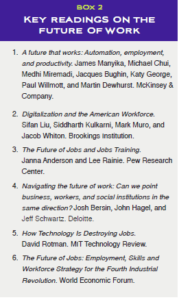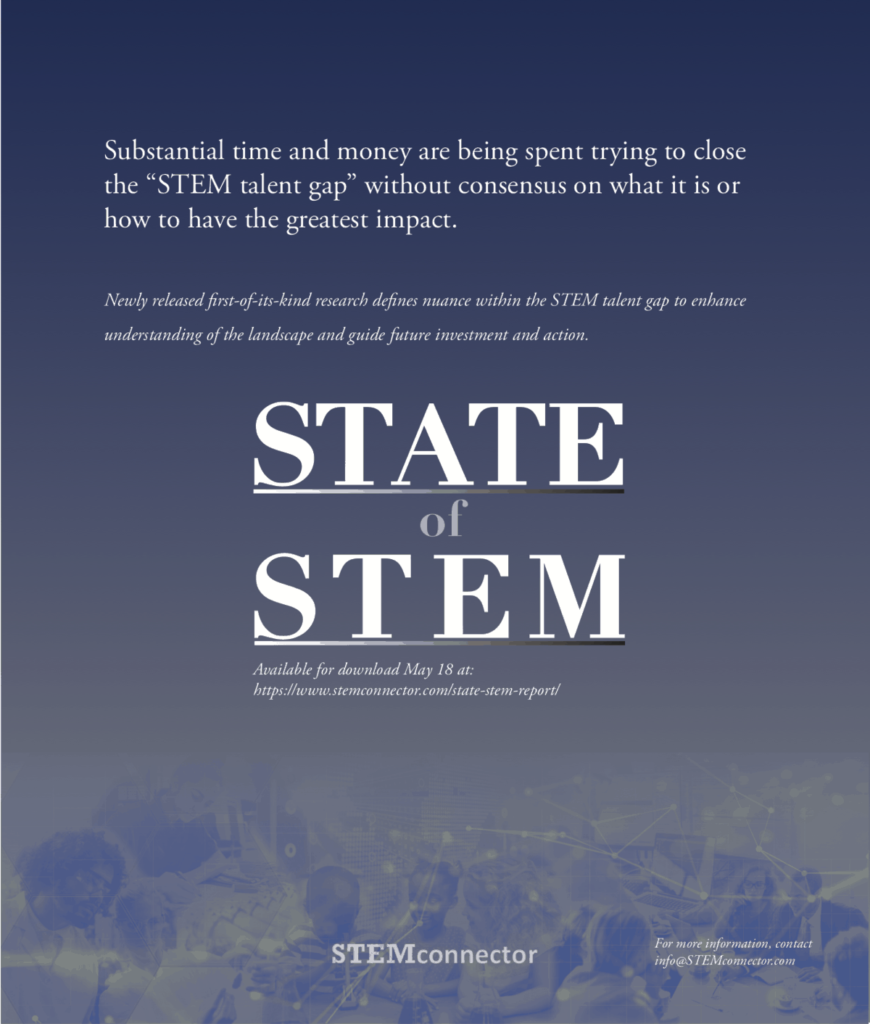STEMconnector released the State of STEM report in May of this year, and we continue to use the framework and research to drive knowledge and action for our networks. We are pleased to share a series of blog posts diving more deeply into the resources found in the call-out boxes included throughout the report. This first piece focuses on Box 2: Key Readings on the Future of Work (page 4 of the report) and provides key takeaways from each of the six featured research pieces.
 A future that works: Automation, employment, and productivity. James Manyika, Michael Chui, Medhi Miremadi, Jacques Bughin, Katy George, Paul Willmott, and Martin Dewhurst. McKinsey & Company.
A future that works: Automation, employment, and productivity. James Manyika, Michael Chui, Medhi Miremadi, Jacques Bughin, Katy George, Paul Willmott, and Martin Dewhurst. McKinsey & Company.
This report from the McKinsey Global Institute discusses the impact of automation on employment and productivity in the global economy.
Key takeaways:
Automation improves efficiency by reducing errors and improving speed. Historically, automation has boosted economic growth and prosperity. Based on scenario modeling, it could raise productivity growth globally by 0.8 to 1.4% annually. The impact of automation should be analyzed at the individual task level, rather than at the overall occupation level. For example, less than 5% of occupations are candidates for full automation and subsequent job extinction. Tasks requiring physical labor are most susceptible to automation, so occupations with more physical labor requirements will experience more rapid transformation. Productivity estimates align with historical data and assume that workers displaced by automation will be able to find other means of employment.
- Digitalization and the American Workforce. Sifan Liu, Siddharth Kulkarni, Mark Muro, and Jacob Whiton. Brookings Institution.
This report from the Brookings Institution analyzes the digital content for 545 occupations, covering 90% of the United States workforce in all industries since 2001, and includes case-studies of employers focused on preparing incumbent workers for the digital workforce.
Key takeaways:
Between 2002 and 2016, the shares of U.S. jobs that require substantial digital knowledge rose rapidly, mostly due to large changes in the digital content of existing occupations. The degree and pace of change of digitalization varies widely among occupations and across industries. Digitalization is associated with increased pay and job resiliency in the face of automation but also vastly uneven trends for job growth and wages, and for individuals based on race and gender. Expanding the high-skill IT pipeline is crucial to keep pace with technological changes.
- The Future of Jobs and Jobs Training. Janna Anderson and Lee Rainie. Pew Research Center.
The Pew Research Center and Elon University’s Imagining the Internet Center canvassed technologists, scholars, practitioners, strategic thinkers and education leaders to better understand the future of workplace training.
Key takeaways:
Education and skill-building programs are increasingly relevant as automation and artificial intelligence (AI) disrupt the workforce. When surveyed, 48% of experts said more jobs will be lost than created by AI and 52% said more jobs would be created than lost. In order to keep up with technological changes, the education system will need to adapt to better prepare individuals for the new economy. Technological advances have also paved the way for more accessible educational opportunities.
- Navigating the future of work: Can we point business, workers, and social institutions in the same direction? Josh Bersin, John Hagel, and Jeff Schwartz.
Technology, demographics, and “the power of pull” are three forces shaping the nature of the future of work and the future workforce. This report delves into the implications of these forces on individuals, businesses, and the government.
Key takeaways:
Technology, demographics, and “the power of pull” serve as forces of change. Work and workforces are redefined because of these forces of change. There are implications for individuals, organizations, and public policy because of workforce transformation. For example, individuals have more opportunity to shape their own career paths, organizations must redesign work functions to adapt to new technologies, and public policy must reassess legal and regulatory policies.
- How Technology Is Destroying Jobs. David Rotman. MIT Technology Review.
Several MIT researchers challenge the projection that new employment opportunities will be created despite some jobs being destroyed by automation.
Key takeaways:
Employment and productivity projections that indicate employment rates have remained stagnant while productivity has continued to soar due to automation. Advances in computer technology are responsible for the past 10-15 years slow employment growth. Technological change is destroying jobs faster than it is creating them. Some historical data indicates that technological advances have not resulted in net unemployment, but research also acknowledges that the speed of automation today is unlike anything from the past.
- The Future of Jobs: Employment, Skills and Workforce Strategy for the Fourth Industrial Revolution. World Economic Forum.
Chief Human Resources and Strategy Officers were surveyed to understand what current technological shifts mean to their organizations, providing information on workforce trends by industry and geography.
Key takeaways:
There is a “modestly positive outlook” on the future of work, but employers face a business imperative to embrace technological disruptions. New categories of jobs will emerge due to technological disruptions, so new skill sets will need to be developed by employees. Changes in the workforce may transform the dynamics of the industry gender gap.
